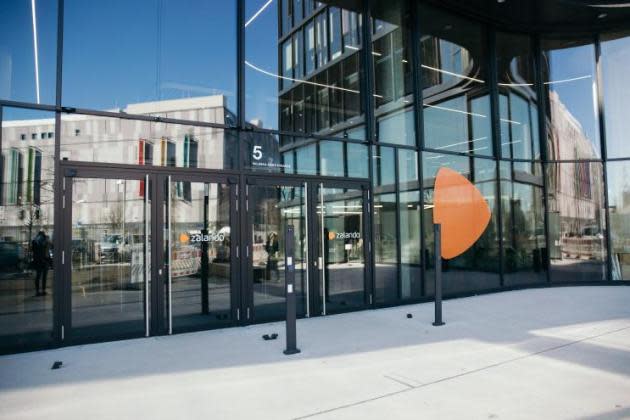Zalando Revenues Down 2.5% in Q2 Amid Challenging Retail Environment

PARIS — European e-commerce giant Zalando saw revenues fall 2.5 percent in the second quarter to 2.6 billion euros amidst “subdued demand” as consumers moved away from pandemic-era online shopping habits and returned to stores.
But net income surged 87 percent to 144.8 million euros year-on-year, as the company grew its fulfillment and logistics, and focused on cost-cutting measures.
More from WWD
Zalando co-chief executive officer Robert Gentz tempered the revenue news, noting that the company had expected weaker demand as online purchases evened out after years of growth. The company entered the year expecting “uncertainties around consumer demand” and instead focused on growing the logistics side of the business, he said.
“The picture is different in regards to our bottom line. This year we continue to implement a range of efficiency measures. The numbers confirm our successful focus on profitability,” Gentz said in a call with analysts following the release.
“Amid the temporarily challenging retail environment, we continue to drive sustainable efficiencies in fulfillment and marketing,” added Zalando chief financial officer Sandra Dembeck. “These efforts have paid off this year with adjusted EBIT almost doubling in the second quarter. Such success puts us in pole position to shift our focus more toward investment and future growth initiatives.”
The results were largely in line with analysts’ expectations, and the company refined its operating profit guidance for the full year, narrowing it from a range of 280 million euros to 350 million euros, to a range of 300 million euros to 350 million euros.
The stock jumped up 8.19 percent in mid-morning trading on the profit news.
“Amidst a challenging backdrop, we believe Zalando is well positioned, owing to its platform strategy and as the leading online fashion destination in Europe, to outperform the online market. Longer-term, the company has ample levers to drive growth including beauty, pre-owned and premium fashion, and we believe group margins can more than double over time,” RBC Europe analyst Wassachon Udomsilpa said in a research note.
Gentz highlighted that the small declines in top-line revenue reflect that the e-commerce industry is steadying itself after years of booming sales. “The last few years there were some artificial tailwinds with the pandemic on e-commerce,” he said. A return to in-person purchases coupled with economic headwinds has slowed the business.
The company looks at the e-commerce metric of gross merchandise value, or GMV, to put a figure on how much inventory the platform has moved separate from its logistics and marketing services. That number was down 1.8 percent to 3.7 billion euros worth of merchandise moved in the second quarter.
The sales slowdown came even as Zalando strengthened its product offering, onboarding new athletic brands including Lululemon and Hoka, and expanding its beauty portfolio with luxury brands Lancôme, Mugler and Shiseido rolling out to more markets. It also launched an exclusive capsule collection with Paco Rabanne (now Rabanne) in April.
Upscaling its brand offer is differentiating it from Chinese low-price clothing upstarts such as Shein, noted Gentz.
“Competition from China has arrived,” he said. “It’s a very different model. We are working with modern, excellent brands and giving the European continent access to high quality brands across a wide range of portfolios. Our offer is very different from the one at Shein and our overlap is not high.”
Zalando added more than 1 million shoppers in the quarter, registering 50.5 million active customers, with mixed results. Five million fewer orders were placed in the quarter, down from 67.8 million to 63.2 million, while the average basket ticked up to 58.1 euros per order from 55.9 euros. Revenues at the fashion store were flat at 2.09 billion euros.
One bright spot that benefited from the competitive retail environment was its off-price shopping club, Lounge by Zalando. The discount division’s revenues were up 16 percent to 436.4 million euros.
“The European consumer may need more time to fully embrace again the e-commerce fashion space, but the current conditions are the same for everyone in our industry,” Gentz said. “The share of e-commerce in fashion will continue to grow at a rapid pace. Even if 2023 is still a year where consumers are holding their breath after the rallies in the years before, the rally will come back soon.”
Zalando’s partner businesses, where brands and retailers directly connect their warehouse inventory to the platform, grew 7 percent in GMV in the quarter, while its fulfillment services sector was up 3 percent year-on-year.
Macro headwinds are also dragging purchasing, but the company continues to invest in tech to build out a robust consumer experience, including improving interaction with those high-profile partner brands.
“I’m very clear e-commerce will come back because it’s grounded in so many structural advantages — including technology, surrounding data and a lot of advances that will enable us to build a superior experience,” Gentz said.
To that end the company launched a ChatGPT-enabled customer interface, as well as an AI-enabled sizing tool based on users’ photos, aimed at lowering the return rate in the test markets of Germany, Austria and Switzerland.
Return rates stabilized in the second quarter based on new sizing recommendations, said Dembeck, with the AI expected to further cut the number of items sent back.
“This tool is a step change solution in the industry that will help customers find the perfect fit before delivery. This is truly exciting as it shows how one of the core challenges in fashion e-commerce can be solved at scale,” Gentz said.
Dembeck briefly addressed the company’s secondhand marketplace without offering numbers on its volume or profitability. “This is something that is seen a lot from a sustainability angle and we really want to extend the lifeline of products. In that respect, it’s performing very well,” she said. “We see a very strong social effect.”
Best of WWD
